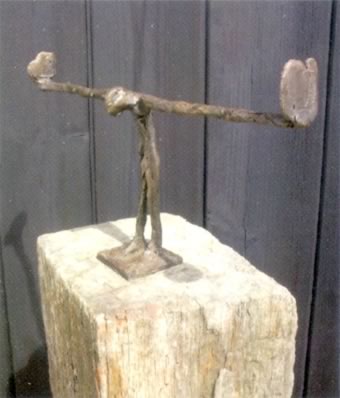SCULPTURE
Inside, Outside
Bronze, Stone, Terracotta, Ceramic, Wood, Resin
Sculptors include
John Atkin
Stuart Anderson
James Copper
John Doubleday
Laurence Edwards
Mark Goldsworthy
Bridget Heriz |
Olivia Musgrave
John Parsons
Roland Piche
John O'Connor
Kate Reynolds
Guy Taplin
Brian Taylor |

Poppy Fields by Lucy Harwood
FEATURING A Collector's Sale
Artists from Benton End, Hadleigh The East Anglian School of Painting and Drawing (1940-1982)
Including:
Denise Broadley (1914-2007)
Olive Cook (1912-2002)
Waveney Frederick (1911-1999)
Lett Haines (1894-1978)
Maggie Hambling b.1945
Lucy Harwood (1893-1972)
Glyn Morgan b.1926
Cedric Morris (1889-1982)

The Cat (1916-1920) by Lett Haines
It did not take long after opening Chappel Galleries in 1986 for us to hear the legendary tales of Cedric Morris and Lett Haines. Having met in London in 1918 they moved to Newlyn, Cornwall, then to Paris. Together, they established the EastAnglian School of Painting and Drawing in 1937 at The Pound, near Higham, Suffolk, living and running the school in the farmhouse.
From then on it is sometimes difficult to separate the legend from the facts. There are so many wonderful stories from all who had connections with that rich and exquisite piece of Suffolk history. Fact, that following the fire at the School in 1940 they moved to Benton End, Hadleigh, Suffolk - legend that Lucien Freud smoking throughout a stop over at the School with David Carr (both young pupils) on the fateful night, inadvertently may have caused the blaze and Alfred Munnings drove past in his open topped car the next morning shouting 'hooray' at the sorry sight, Munnings regarding Morris as a 'modernist' upstart.
At its new location the School proceeded to attract a 'wide variety of odd and interesting people'. This was not surprising as it was run on uniquely individual, private terms; no formal classes at all.
The heady garden of irises, Cedric being a renowned plants man, the big lunches, the exotic visitors and the students were the School but over and above all, was the painting. Glyn Morgan* who joined Benton End in 1944 remembers "It was a world apart, where painting was the most important thing in life; for Cedric, I think, the only important thing except for his beloved plants".
At the age of fifteen, Hadleigh born Maggie Hambling attended the School but by then her youth was an exception for after the 1960s the average age of students rose with Cedric's and Lett's increasing years and the students with them, old ones repeatedly returning as friends. Students like Lucy Harwood, an eccentric old lady who walked from Layham carrying her basket of buns in time for tea and who was totally dedicated to painting. In addition, Lett, who held the place together, had taken a stand to devote more time to his own art and so eventually that exuberant era slowly came to an end.
Lett Haines died in 1978 and Cedric Morris in 1982 but my goodness, do they survive - and their legends!
* Glyn Morgan: several solo shows at Chappel Galleries including exhibition 1994 "Master and Pupil" Cedric Morris and Glyn Morgan
COLLECTING ART WORKS IN 2009
I always say buy because you like it and not to treat the buying of art like betting on horses. In this way, come what may, you will have enjoyed it. This would extend to the making of a collection of art.
What is meant by collecting artl Nowadays this is an even broader term than ever before. For instance, it is often used as a gentrified term for dabblers in buying art who hope to make a buck or so in the process. With all the publicity and access to art now there are many amateur 'dealers' out there, who like to disguise themselves as 'collectors'. My perception of the more genuine art collector is someone who is passionate about artefacts and buys slavishly to keep and treasure. Over the years it becomes a Collection, unselfconscious and genuine. This might gain its own momentum with selling, exchanging and purchasing to further the collection.
There are, of course, those collectors who are more disciplined and wish to keep their art works within certain parameters for various reasons, some financial, some aesthetic and they can be just as obsessional, just like any anorak! There are so many criteria for the collector to collect: To follow the career of a particular artist can be most gratifying; to keep to a 'style' or type of art Le. paintings, sculpture, drawings. Period is one of the most often adhered to, especially with the more academic collector. The nineteen fifties/sixties have been popular for a while - with the strong figuration of the fifties leading into the Pop culture ofthe sixties which has become almost 'traditional'. To go for the Modern Contemporary of today might seem outlandish now but could be interesting long term. This is an area which deserves exercising an honesty of reasoning, and not just to go with the 'hype'.
Lastly, I would suggest (well 1 would wouldn't 11) to collect as substantively as you can. By this, I mean push the boat out - buy the best of an artist's work that you can possibly afford. You will not regret it!
Edna Mireck

Reynolds
 O'Connor
O'Connor |
 Goldsworthy
Goldsworthy |
 Copper
Copper |
 Heriz
Heriz |
|


